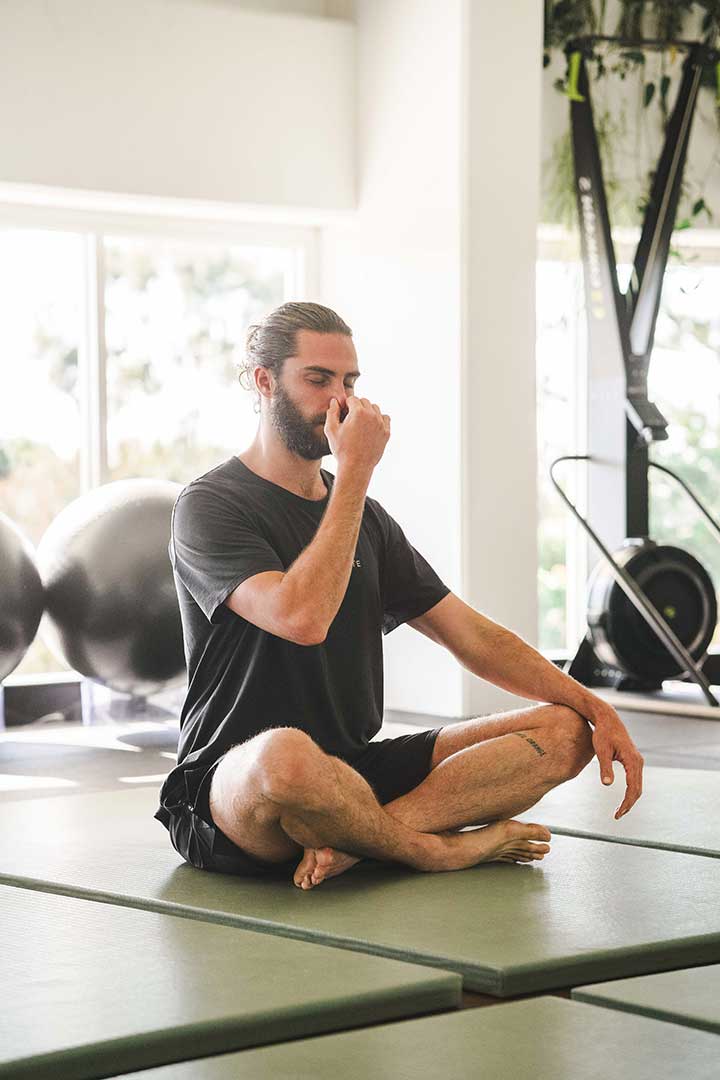Key Takeaways:
- Anxiety often settles in quietly, mistaken for stress or busyness, until it becomes a constant undercurrent in the body.
- Learning how to reduce anxiety naturally begins with recognising when the nervous system is stuck in high alert.
- Stress is a response to pressure; anxiety is a lingering sense of disconnection from safety, presence, or self.
- Everyday habits like skipping meals or constant rushing can quietly reinforce the body’s sense of urgency.
- Breath-led movement and gentle rhythm help signal to the body that it’s safe to soften, settle, and restore.
You might not notice exactly when it began. A few restless nights. A shorter fuse than usual. That subtle sense of rushing through the day, even when there’s no need to. At some point, you realise your breath is shallow, your mind is full, and your body feels like it’s quietly bracing – as if waiting for something, even in stillness.
Anxiety has a way of arriving softly. It doesn’t always shout. Sometimes, it lingers in the background for weeks, even months – explained away as stress, busyness, or just “how life is right now.”
But this constant state of inner alertness isn’t something we’re meant to live with. And it’s not just a mental experience. It settles into the body – shaping the way you breathe, digest, sleep, and move through the world.
Learning how to reduce anxiety naturally begins by noticing this, and gently responding with care.
Not Just Stressed: Learning To Recognise When It’s Actually Anxiety
Anxiety isn’t always loud or obvious. It can appear as tension in the chest, a racing mind, restless sleep, or simply a sense that something isn’t quite right. Sometimes it hides behind overthinking or overdoing. Other times, it just feels like the body is moving faster than the moment calls for.
It helps to know that anxiety and stress, while connected, aren’t the same.
Stress is usually a direct response to a specific demand – a deadline, a conversation, an unexpected change. Anxiety, on the other hand, is more like the echo – a lingering sense of unease, often tied to future unknowns, uncertainty, or a feeling of being disconnected from ourselves.
When the nervous system is under constant load, it can tip into overdrive. Breathing becomes shallow, digestion changes, the body speeds up even at rest. This isn’t a flaw – it’s the body doing its best to keep up. But over time, this high-alert state becomes draining, and the sense of imbalance starts to feel normal.
Recognising anxiety for what it is – not weakness, not “too much,” but a signal that something needs attention – is often the first step toward finding real relief.
What Fuels the Fire: Everyday Habits That Keep Us Stuck in Overdrive
Once we recognise anxiety, the next step is exploring what might be fuelling it. Not in a blaming way – but with curiosity. Often, it’s not one big thing, but a collection of everyday habits that slowly build pressure in the system.
Skipping meals, living on caffeine, scrolling late into the night, always rushing from one task to the next – these patterns are so common they can seem normal. But they quietly send signals to the body that it’s not safe to slow down.
Even well-intentioned behaviours, like high-intensity workouts or productivity routines, can sometimes reinforce a sense of pressure when what we actually need is spaciousness, rest, or rhythm. Becoming aware of these patterns helps us choose differently – not perfectly, but more consciously.
The Breath Knows: Reconnecting With Your Most Trustworthy Anchor
When anxiety clouds the mind, the breath is often the first to shift. It becomes shallow, fast, held. Yet it’s also the first place we can return to – a quiet, built-in rhythm that gently reintroduces calm.
At Native State, we often guide clients to notice not just how they’re breathing, but why. Is there tension in the body? Have they been under pressure or pushing through? Understanding the story behind the breath helps avoid the mistake of forcing it into stillness when it may not be ready.
That’s why breathwork is personal. For some, slowing the exhale brings instant relief. For others, it’s about simply noticing – creating space between the inhale and the next thought. Whatever the entry point, the breath is an invitation. Not to fix, but to feel – a foundational step in learning how to reduce anxiety naturally, from the inside out.
Try this: Place one hand on your belly and one on your chest. Without changing anything, just observe the movement of your breath for a full minute. Notice where it rises, where it holds, where it rushes. This simple check-in creates awareness – not to correct, but to connect. From here, softening the exhale or simply deepening the next breath can happen without force.
Movement That Calms Instead of Overwhelms
Once the breath begins to soften, movement can follow – not to push the body, but to move in a way that feels steady and supportive.
Not all movement soothes anxiety, especially if it pushes an already overstimulated system. That’s where the concept of “working in” becomes powerful. Rather than striving for intensity, this kind of movement asks, what would feel nourishing right now?
Breath-led practices like yin yoga, slow mobility work, or tai chi offer more than physical benefit – they help the nervous system downshift. These are movements with softness and presence, reminding the body it doesn’t have to brace itself anymore.
When movement is guided by breath and awareness rather than force, something shifts. Not just physically, but emotionally. The body starts to feel safe again – and from there, everything else can begin to unwind.
Try this: Set a timer for five minutes. Let your breath lead, and allow your body to move intuitively – a stretch, a sway, a gentle roll of the shoulders. No goal, no sequence. Just movement that feels good in the moment. Let this be less about doing, and more about listening.
Building Rhythms That Invite Your System to Settle
After reconnecting with breath and movement, the next layer of support often comes from how we shape our days.
Anxiety thrives in unpredictability – too much screen time, skipped meals, working late into the night. These disruptions may seem small, but to the nervous system, they send a message of instability.
One of the kindest things we can offer ourselves is rhythm. Not rigid routine, but a steady pattern the body can trust. Waking and sleeping at similar times. Eating balanced meals at regular intervals. Creating space for breaks, for breath, for unwinding.
At Native State, our coaches support clients to build rhythms that feel natural and sustainable. Not a list of rules, but a framework for steadiness – so the body knows what’s coming next, and no longer needs to stay on guard.
Try this: Choose one anchor point in your day – a morning walk, a nourishing lunch, or a wind-down ritual before bed. Commit to it for the next week, not as a task, but as a promise of rhythm. Let this one steady moment be a cue to your system: you’re safe, and there’s no rush.
Turning Tools Into a Way of Living
Breath, movement, and rhythm aren’t quick fixes – they’re anchors. Gentle, repeatable ways to support your nervous system day by day. When woven into life with consistency, they shift from being practises into something deeper: a felt sense of safety that lives in the body.
It’s not about doing them all perfectly, or all at once. It’s about coming back – to your breath when the mind speeds up, to movement when tension builds, to rhythm when the world feels chaotic. These are small acts of remembering. And over time, they change the baseline from urgency to ease.
This is how we reduce anxiety naturally: not by overriding it, but by meeting it with steady presence, over and over again.
Letting the Nervous System Relax
When we shift out of chronic anxiety, the body can sometimes respond with tiredness, emotion, or a strong desire to rest. This isn’t a setback – it’s recalibration. A sign your system is processing and releasing what it no longer needs to hold.
After breathwork or gentle movement, honour the softness. Hydrate, nourish, and give yourself permission to be still. Avoid stimulation where you can. Let the nervous system integrate.
Recovery isn’t something to rush. It’s something to receive. Especially when you’ve been holding so much, for so long.
How You Know Your System’s Starting to Settle
The shift out of anxiety doesn’t always come with fireworks. More often, it arrives quietly – in the in-between moments. A slower breath. A softer jaw. A sense that you’re meeting life with just a little more ease.
You might notice:
- A steadier energy across the day, without the highs and crashes
- Sleep that feels more restorative, and mornings that aren’t quite so heavy
- A return of focus, or moments of unexpected clarity
- Less reactivity, more ability to pause
- A deeper trust in your own rhythm
These are signs your system is no longer running from moment to moment. It’s settling. And in that settling, you’re coming home to yourself.
Conclusion: Calm Doesn’t Come From Doing More – It Comes From Reconnecting
Anxiety often begins in disconnection – from your body, your needs, your sense of safety. But calm isn’t something you chase down. It’s something you return to.
With breath, gentle movement, and daily rhythms that support your nervous system, you create the conditions for ease to arise naturally. Not by overriding the anxiety, but by listening to what it’s asking for.
You don’t need to power through. You need to come back – slowly, steadily – to what supports you. And in doing so, you return to a version of yourself that feels grounded, capable, and clear.
Private Coaching at Native State: A Calmer Way Forward
You don’t need to navigate anxiety alone – or push through it with more effort. With the right tools and steady support, calm becomes something you build from the inside out.
Private Coaching at Native State is here to guide you gently through breathwork, movement, and daily rhythms that support nervous system healing.
Book a discovery call and start your journey towards natural, lasting relief here.



